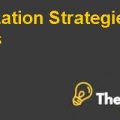
Company Overview
Citibank had started its operations as a small commercial bank in the New York City in 1812 and after a long struggle for a number of years the company had made its market distinction as one of the world’s leading financial institutions. In 1983, the bank had reported revenues of $5.3 billion from more than 2,600 branches that were operating in about 95 countries across the globe. The company had employed more than 63,000 employees from different countries of the world and provided competent and highly convenient training opportunities for their employees, which was considered as one of their kind at that time. The core activities of the bank were organized into three major business units: individual banking, capital market group and institutional banking. The institutional banking of the company was developed with a purpose to provide services and develop different products for different public and private sector corporations of the country. It was responsible for providing commercial loan and some other sort of financial services, i.e. asset based financing, foreign exchange and electronic banking to a wide range of institutions including a number of public and private sector corporations. The individual business unit of the company was not exposed to all the 95 countries because of the high level of risk and complexity involved in its operations. Therefore, it was operating in the US market and about 18 other countries and providing traditional banking services, i.e. lending, saving and transactional services to the individual customers. Whereas, the capital market business unit of the company served as a financial intermediary to manage the flow of funds from the provider to the user. The company’s capital market business had recognized itself as a leading investment bank in the world with the support of 3500 employees throughout the worldwide branches of the company. Being an investment bank, the company had a number of growth opportunities in the developing countries and therefore, it has been earning above the budgeted amounts of profits and revenues from its Indonesian setup, which was headed by the Mehli Mistri, the country corporate officer. The reason behind the attractive numbers in revenues and ROA figures was the competent and the risk taker management style of the developing countries because they usually set their budgets and targets a bit above than the one specified by the corporate office of the company.
Situation Analysis
Mr. Mehli Mistri was working with the bank from a long time and achieved a number of goals over the period of his employment; therefore, in recognition of his efforts and skills, the corporate office of the company had appointed him as a country head of Indonesia by the end of 1979. Right after his appointment, he had struggled a lot to increase the performance of his office because the compensation plan of the company was totally based upon the individual and group performance of the business unit, i.e. 70% on individual performance and 30% on the corporate performance. Within only 5 years of his appointment, he had crossed the growth rate specified by the corporate office of the company, which was 12 to 15 percent per annum. However, in 1983, the corporate office of the company had increased the after tax profit goal of its South East Asian divisions to $4 billion for the year 1984. Mr. Gibson, who was an immediate superior of Mr. Mehli Mistri had decided that the share of the Indonesian office of the company should be between $500,000 to $1,000,000.
The budgeting process at the Citibank was bottom up process, which was initiated by the corporate office of the company, when it had sent a notification to all the divisions of the company, which specified an overall budget to all the divisions, but the document didn’t include clear information regarding the specific targets to be achieved by the divisions along with the overall budget. However, it had specified the combined long term goals of the corporation, i.e. the corporations should grow with a growth rate of 12 to 15 percent and retaining the return on asset ratio at 1.25% with a return on equity ratio of 20%. Apart from the budgeting, Citibank also sets sovereign risk limits for its international operations by the end of each passing year, which was solely based upon the countries economical and overall risk analyses. The term sovereign risk had a wider meaning and included a number of factors, i.e. the macroeconomic risk, exercising control over the foreign exchange of the country, and a number of other factors that would be employed by the government of the host country to limit or make difficulties for the clients to pay their obligations....................
This is just a sample partial case solution. Please place the order on the website to order your own originally done case solution.
Describes the dilemma faced by the country manager for Citibank Indonesia. His boss asked him to raise his profit target for 1984. But to increase profits he would either have to reduce the amount loaned at below-market rates, in particular, the prime customers and government agencies, or to increase the sovereign risk of the bank during the crisis in the Indonesian economy. The goal is to illustrate the role of the regional managers and some of the difficult trade-offs they face. "Hide
by Kenneth A. Merchant Source: Harvard Business School 10 pages. Publication Date: October 25, 1984. Prod. #: 185061-PDF-ENG












